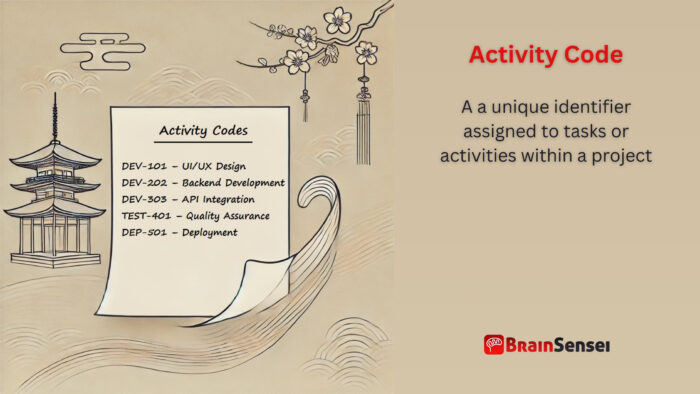
Activity Code
What is an Activity Code?
In project management, an activity code is a unique identifier assigned to tasks or activities within a project. It helps categorize, filter, and analyze project activities based on predefined criteria, such as project phases, work types, or responsible teams. Activity codes enhance project tracking, reporting, and scheduling efficiency, particularly in large-scale projects with multiple tasks.
Key Takeaways
- Categorization Tool: Helps classify project activities for better organization and reporting
- Improved Scheduling: Activity codes empower project managers to filter and sort activities efficiently, saving valuable time and ensuring effective task management.
- Enhanced Reporting: Simplifies tracking of work progress across different categories
- Customization: Activity codes are not rigid structures. Project managers can tailor activity codes to specific project needs, such as departments, cost centers, or work types. This flexibility empowers project managers to adapt the system to their unique requirements, enhancing their control over the project.
- Essential for Large Projects: Activity codes are crucial for managing complex workflows and dependencies in large projects. Their use reassures project managers that the project is being managed effectively.
Understanding Activity Codes in Project Management
How It Works
Activity codes are used in project management software, such as Primavera P6 and Microsoft Project, to group and manage tasks effectively. These codes can be assigned based on:
- Project Phases (e.g., Planning, Execution, Closure)
- Task Types (e.g., Design, Procurement, Construction)
- Resource Allocation (e.g., Engineering Team, IT Department)
- Geographical Locations (e.g., Site A, Site B)
- Work Breakdown Structure (WBS) Levels
Once assigned, the codes allow project managers to filter, sort, and analyze activities based on specific parameters. This assignment makes tracking progress, generating reports, and meeting project milestones easier, fostering a sense of connection among team members.
Important Considerations
- Too Many Codes Can Cause Confusion: Keep the structure simple and logical.
- Standardization Across Projects: Use a consistent coding framework to ensure uniformity.
- Integration with WBS & Cost Codes: Align activity codes with the project’s Work Breakdown Structure and budget tracking.
- Automation in Scheduling Software: Use project management tools to apply and manage activity codes efficiently.
- Avoid Redundancy: Ensure codes are distinct and meaningful to project stakeholders.
Related Terms
- Work Breakdown Structure (WBS): A hierarchical decomposition of project work into manageable sections.
- Project Schedule: A timeline-based representation of activities and their dependencies.
- Gantt Chart: A visual scheduling tool that displays project activities, durations, and dependencies.
- Cost Code: A financial classification system for tracking project expenses.
- Baseline Schedule: Project managers use this originally approved project schedule for performance tracking.
Examples of Activity Codes in Different Industries
Construction Industry
A large-scale commercial building project assigns activity codes to different work phases to ensure proper sequencing and accountability. Each task is categorized using a structured coding system:
- 1001 – Site Preparation
- 2001 – Foundation Work
- 3001 – Structural Framing
- 4001 – MEP Installations
- 5001 – Interior Finishing
For example, during the foundation phase (2001), these codes foster collaboration among team members and help track specific sub-tasks such as excavation, concrete pouring, and reinforcement. The project manager can filter activities by phase to inspect the activity dependencies. If excavation delays occur, the impact on subsequent structural framing (3001) can be assessed and mitigated. Contractors, engineers, and site managers collaborate efficiently using these codes, reducing downtime and optimizing workflow.
IT & Software Development
A software development project for a banking app categorizes activities using activity codes aligned with Agile sprints and development tasks:
- DEV-101 – UI/UX Design
- DEV-202 – Backend Development
- DEV-303 – API Integration
- TEST-401 – Quality Assurance
- DEP-501 – Deployment
During sprint planning, the team uses these codes to track progress. If a security vulnerability delays an API integration (DEV-303), project managers can quickly assess which dependent tasks (such as testing under TEST-401) will be affected. In large development teams, these codes streamline communication between developers, testers, and product managers, ensuring tasks align with project milestones.
Healthcare Facility Expansion Project
A hospital expansion project involves multiple stakeholders, departments, and regulatory requirements. Activity codes help categorize tasks and maintain compliance. Here’s an example of how they are applied:
- HOS-001 – ER Renovation
- HOS-002 – New Wing Construction
- HOS-003 – Medical Equipment Installation
- HOS-004 – IT System Upgrade
Consider the new wing construction (HOS-002). The project team must coordinate architectural design, material procurement, and structural work. By assigning specific codes to each task, managers can track which phase is at risk of delay. If medical equipment installation (HOS-003) depends on structural completion, the codes help prevent scheduling conflicts and ensure smooth transitions between construction phases. This structured approach improves patient care readiness by ensuring timely project completion.
Renewable Energy Project
A wind farm project in Germany applies activity codes to track turbine installation, electrical connections, and grid integration. This process ensures compliance with environmental regulations and project deadlines.
- WIND-100 – Site Survey & Preparation
- WIND-200 – Foundation & Tower Installation
- WIND-300 – Turbine Assembly
- WIND-400 – Electrical & Grid Integration
- WIND-500 – Testing & Commissioning
For example, delays in turbine assembly (WIND-300) due to supply chain disruptions could impact electrical integration (WIND-400). These codes allow engineers to adjust schedules dynamically, ensuring alternative tasks progress without halting the entire project. By monitoring each phase closely, project managers can efficiently address logistical challenges.
Manufacturing Plant Expansion in Japan
A major electronics manufacturer in Japan is expanding its production facility to accommodate increased demand for semiconductor chips. The project involves multiple concurrent activities that must be meticulously tracked using activity codes:
- MFG-001 – Site Development
- MFG-002 – Factory Construction
- MFG-003 – Equipment Procurement & Installation
- MFG-004 – Quality Control & Testing
The company uses these codes to manage critical dependencies. For example, if factory construction (MFG-002) encounters delays due to zoning approvals, procurement and installation (MFG-003) must be rescheduled. Without structured activity coding, such setbacks could lead to costly production delays and revenue losses.
Transportation & Logistics Project
A global shipping company upgrades its logistics hub in Singapore to improve efficiency. Activity codes categorize infrastructure improvements, technology upgrades, and operational changes:
- LOG-101 – Facility Expansion
- LOG-202 – Warehouse Automation
- LOG-303 – IT System Migration
- LOG-404 – Security Enhancements
When warehouse automation (LOG-202) begins, managers track progress to ensure it aligns with IT system migration (LOG-303). If an issue arises in automation testing, the project team can reschedule related IT upgrades. These codes provide visibility across departments, ensuring smooth transitions between logistics upgrades and operational improvements.
These industry-specific examples illustrate how activity codes enhance project tracking, improve coordination, and mitigate risks, ensuring successful execution.
Use Cases of Activity Code in Project Management
United States (Infrastructure Development)
In the United States, a major highway expansion project in California relies on activity codes to manage complex construction phases. The project involves road widening, bridge reconstruction, and utility relocations. Each project segment is assigned unique codes to track labour, material deliveries, and subcontractor schedules. Project managers can identify delays, ensure resource availability, and coordinate with state regulatory agencies by categorizing activities. When unexpected weather conditions disrupt concrete pouring, the codes help reschedule tasks while aligning with project deadlines. Using these codes ensures that all stakeholders have visibility into project progress, preventing cost overruns and construction delays.
Spain (Renewable Energy Project)
A wind farm development in Spain utilizes activity codes to optimize project scheduling and resource allocation. The project includes site preparation, turbine installation, electrical connections, and grid integration. These codes help engineers track dependencies between tasks, ensuring that turbine assembly does not begin before foundation work is complete. Project managers use these codes to adjust schedules and assign teams to alternative tasks when delays occur due to a critical component shipment or customs clearance issues. This flexibility prevents downtime and ensures steady progress. Additionally, these codes facilitate communication between international suppliers, construction teams, and government agencies, ensuring compliance with European environmental regulations.
Dubai (Smart City Development)
In Dubai, a smart city project integrates activity codes into its project management framework to streamline urban infrastructure development. The initiative includes intelligent traffic management systems, renewable energy installations, and AI-driven public services. Each phase, from data center construction to IoT sensor deployment, is assigned codes to track execution status. When new sustainability mandates require adjustments to energy grid installations, these codes allow engineers to quickly identify and modify affected activities without disrupting other aspects of the project. This structured approach enhances coordination between government agencies, technology firms, and construction companies, ensuring timely and cost-effective project completion.
By strategically implementing activity codes, organizations in various industries can enhance efficiency, improve coordination, and ensure successful project execution.
Best Practices for Using Activity Code
Define a Clear Structure
Establish a standardized format for activity codes that is easy to understand and use. Avoid overly complex or arbitrary numbering systems, and ensure consistency across projects.
Align with Project Objectives
Activity codes should reflect project milestones, work breakdown structures, and cost categories. This alignment ensures that tracking and reporting are meaningful and actionable.
Integrate with Project Management Tools
Automate activity code assignment and reporting using Primavera P6, Microsoft Project, or ERP systems. Integrating digital tools improves efficiency and reduces manual errors.
Regularly Review and Update Codes
Project dynamics change over time, requiring periodic updates to activity codes. Establish a review process to ensure that codes remain relevant and valuable.
Train Project Teams
Ensure that all stakeholders, including project managers, engineers, and financial analysts, understand the purpose and application of activity codes. Training reduces misinterpretations and enhances collaboration.
Use Activity Codes for Performance Analysis
Activity codes facilitate detailed performance tracking, helping identify bottlenecks and inefficiencies. The project team can also use historical data to optimize scheduling and resource allocation.
Ensure Compliance with Industry Standards
Many industries have regulatory requirements related to project tracking. A structured activity code system can help organizations comply with reporting and auditing standards.
Enhance Cross-Team Communication
Activity codes improve communication between departments, subcontractors, and suppliers by categorizing work in a structured manner. This understanding fosters collaboration and prevents project misalignment.
By following these best practices, organizations can maximize the benefits of activity codes, ensuring efficiency, accuracy, and successful project delivery.
Activity Code: Common Mistakes and Issues
Overcomplicating the Coding System
One of the most common mistakes in implementing activity codes is creating too complex. Project teams sometimes attempt to account for every possible scenario, leading to excessively long or convoluted codes. This complexity makes it difficult for team members to remember or correctly apply the codes, leading to confusion and inefficiencies. A best practice is to keep these codes simple and intuitive while ensuring they convey meaningful information.
Lack of Standardization Across Projects
Different departments or projects may use different activity code structures without a standardized approach, making integrating data or comparing performance across projects challenging. For example, one project might use numerical codes while another uses alphanumeric identifiers. This inconsistency can hinder effective reporting and benchmarking. Organizations should establish and enforce a uniform code framework to mitigate this issue.
Inadequate Training and Communication
Even with a well-designed system, failing to properly train team members to use activity codes can lead to widespread errors. Employees may apply incorrect codes, leading to inaccurate project tracking and misreported data. Provide training sessions and clear documentation to ensure all team members understand how to use activity codes correctly.
Failure to Update Codes as Projects Evolve
Projects are dynamic, and requirements often change over time. A common mistake is failing to update activity codes to reflect these changes. Tracking and reporting inaccuracies can arise when introducing a new phase or workstream, but the code structure remains unchanged. Regularly review and update the activity coding system to ensure continued relevance.
Poor Integration with Project Management Software
Many organizations use software like Primavera P6, Microsoft Project, or ERP systems to manage project activities. Correctly integrating the activity codes into the systems prevents teams from struggling with manual data entry and reporting inconsistencies. Ensuring seamless integration between the codes and project management software improves automation, reduces errors, and enhances reporting accuracy.
Redundancy and Duplication in Code Assignments
Duplicate or redundant activity codes can create confusion and inefficiencies in project tracking. For instance, reporting accuracy suffers if two similar activities are assigned different codes due to a lack of coordination. To prevent this confusion, a centralized team should oversee the code assignments to minimize duplication and ensure distinct codes.
Inconsistent Use of Activity Codes Across Teams
Different teams within the project may interpret activity codes differently, leading to inconsistencies in reporting and tracking. For example, the procurement team may use a different set of codes than the project management team for the same tasks. Establish and enforce a clear, organization-wide policy on activity code usage to maintain consistency.
Ignoring Compliance and Regulatory Requirements
Failure to align activity codes with compliance requirements in regulated industries such as healthcare, construction, and finance can have legal and financial repercussions. Organizations that do not structure these codes to support regulatory reporting may struggle with audits and risk management. Align these codes with relevant industry regulations to maintain compliance and reduce operational risks.
Overlooking Performance Analysis and Optimization
Activity codes are not just for categorization; they are valuable tools for performance analysis. Some organizations fail to leverage these codes to analyze project efficiency, identify bottlenecks, or optimize workflows. By using these codes to track trends, teams can make data-driven decisions to enhance productivity and cost-effectiveness.
Resistance to Adoption by Project Teams
Finally, getting all stakeholders to adopt and use activity codes consistently is a significant challenge. Project teams may resist implementation if they perceive the system as cumbersome or unnecessary. Leaders must emphasize the benefits of using codes, demonstrate their impact on efficiency and accuracy, and encourage active participation through training and support.
Addressing these common mistakes and implementing best practices can help organizations effectively use activity codes while enhancing project management efficiency and success.
Activity Code: Frequently Asked Questions (FAQs)
Why are activity codes necessary in project management?
Activity codes help categorize and track tasks, improving project organization, reporting, and efficiency, especially in large-scale projects.
How do activity codes differ from WBS codes?
WBS codes define the project’s structure and hierarchy, while activity codes categorize tasks based on specific attributes, such as work type or location.
Can activity codes be customized for any project?
Project teams can tailor activity codes to meet project needs, phases, resources, or other criteria.
Which software tools support activity codes?
Popular project management tools like Primavera P6 and Microsoft Project support activity code functionality.
How can activity codes improve project scheduling?
It enhances scheduling accuracy and efficiency by allowing managers to filter and sort tasks based on relevant criteria.
Additional Resources
Preparing for a PMI certification?
- Exam Prep Courses: PMP®, CAPM®, and PMI-ACP®
- Exam Simulators: PMP®, CAPM®, PMI-ACP®, PMI-PBA®, PMI-RMP®, PMI-SP®, PgMP®, and PfMP®
- Professional Development Units (PDUs): 15, 30, and 60 PDU Bundles



